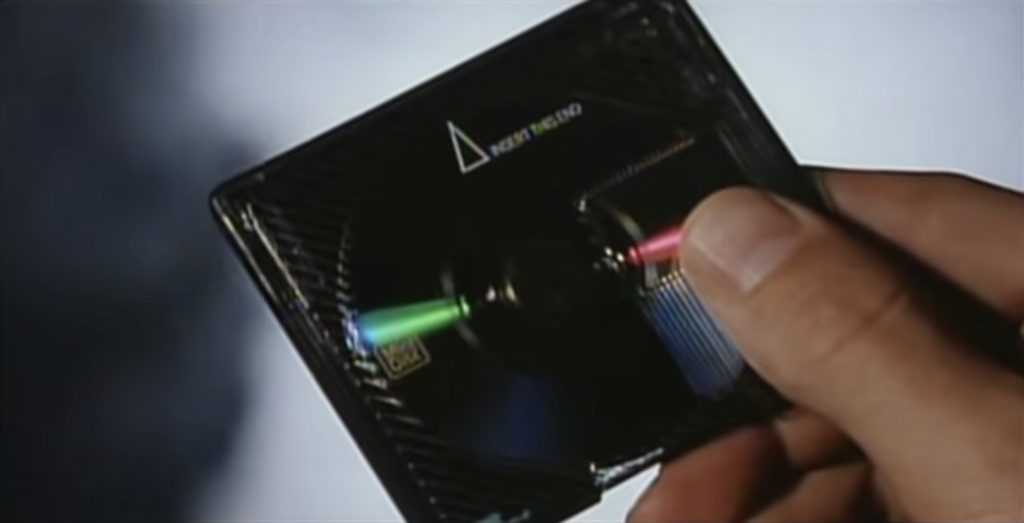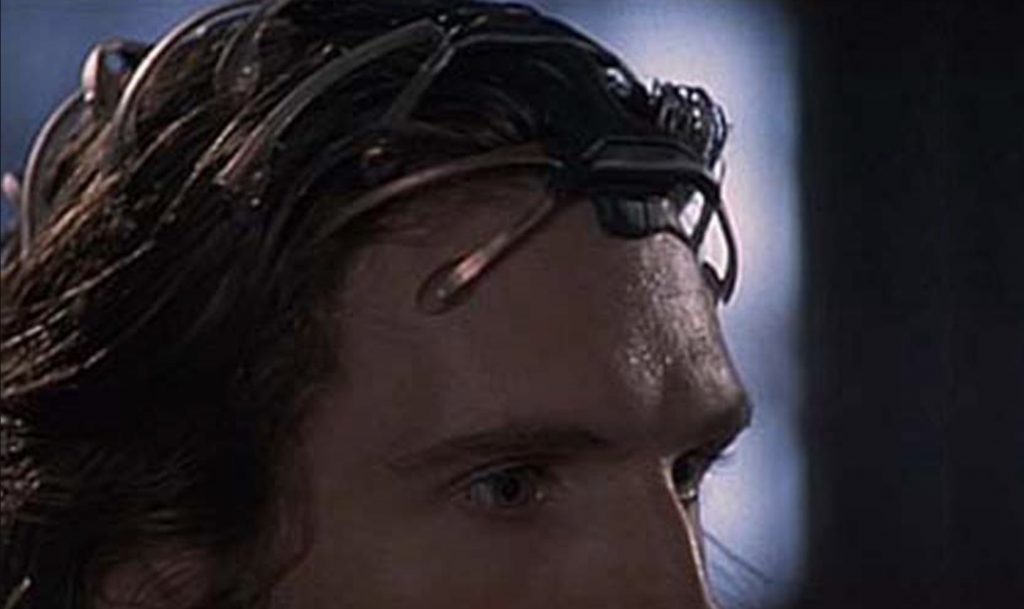Core Data:
- Vision: a device that can record and playback someone else’s memories
- Type: Film
- As Seen In: Strange Days
- Envisioned: 1995
- Visionaries: Kathryn Bigelow (director), James Cameron (story)
- Target Date: 1999
Overview:
Despite being directed by future Oscar-winner Kathryn Bigelow, and based on a story by James Cameron – then extremely hot off the back of Terminator 2: Judgment Day – Strange Days was a commercial disaster when it was released in 1995. It deserved better, however, because it’s a dark, intelligent crime noir with an intriguing sci-fi edge.
Against a backdrop of a crime-ridden Los Angeles in the then-future of 1999, former cop Lenny Nero (Ralph Fiennes in strangely leftfield piece of casting) runs a successful black market business dealing memories. Thanks to a machine known as a SQUID, it’s possible to record and playback another person’s experiences, but Lenny bites off more than he can chew when a file depicting a brutal murder comes into his possession.
Bigelow wisely makes use of ’90s tech to portray the SQUID, giving it a grungy, believable aesthetic. But just how feasible – and desirable – would it be to experience another person’s memories? We take a deep dive into the tech of Strange Days…

Key tenets:
- Hardware: The recording and playback of memories is made possible by the SQUID.
- SQUID stands for Super-conducting Quantum Interference Device.
- A SQUID consists of a receptor rig connected wirelessly to a nearby recording unit.
- The receptor headset is a loose mass of wires and electrodes that fit over the user’s head. It is capable of both receiving information from the user, and transmitting information directly into another user’s mind.
- For covert recordings, headsets are often hidden under wigs.
- The recording device resembles a MiniDisc player, with memories stored on 60-minute MiniDiscs.
- As well as connecting the SQUID to a recorder, a simple hack can allow another user to share your experiences live.
- SQUID recordings are transferred between users on MiniDiscs – dealing content is as much about handing over a physical object as exchanging the content on it.
- Experience: Recordings allow the user to experience the sights, sounds and physical sensations felt by the person who created the memory – for the duration of playback, you essentially feel what it’s like to be them.
- While this means you could theoretically find out what it’s like to score the winning goal in the World Cup Final or reach the top of Everest, the technology is more commonly used for recordings related to sex and/or violence. Humans are such predictable creatures…
- The tech is not without its dangers, particularly on the unregulated black market. While signals can be amplified to enhance the experience, this modification can result in the overloading of a user’s frontal lobe. This effectively fries their brain, leaving them in a perpetual – but seemingly blissful – coma for the rest of their lives.
- Company: While the SQUID technology was originally created by law-enforcement authorities, as an alternative to concealed microphones, it is now predominantly available on the black market – and seemingly unregulated.
- Economics: SQUID units appear to be relatively widespread and common, but it’s safe to assume that the real money is in the content. This is a similar to the model used in the games industry, where consoles have historically been sold as loss leaders, in order to make the money back later via sales of games.
- The highest value SQUID recordings tend to be the rarest or most extreme, and generally contain extremely illicit content.
- IP: Arguably the most valuable intellectual property of all – other people’s thoughts and memories.

State of Play (July 2022)
- Hardware: Twenty-seven years after the movie’s release, the equipment in Strange Days is a strange contradiction – defunct technology performing tasks that are still impossible and – let’s be honest – may never be feasible.
- While neural interfaces do exist – attaching to the skull in much the same way as the SQUID – they’re nowhere near the sophistication seen in the movie. While very simple commands can be passed from human to machine, technology with the ability to exchange more complex information is yet to be invented.
- Another challenge in making the SQUID a reality is designing a computer to simulate human brain activity would probably require significantly different architecture to anything currently in existence. Put simply, nobody knows how to store what’s going on in your mind.
- Developed by Sony and launched in November 1992, the MiniDisc was a digital recording medium. While playback sound quality was slightly inferior to a compact disc, the MiniDisc had the added advantages of being smaller, more robust and – most importantly – recordable. Ultimately, however, the timing of its launch proved to be rather unfortunate as it was eventually killed off by the MP3 revolution of the early 21st century. In an iPod world, physical media lost its appeal, and Sony sold its last MiniDisc player in 2013.
- A standard 80-minute MiniDisc could hold 305 megabytes of data, but even the later iterations that could support a gigabyte of information would surely be inadequate for an hour-long neural recording. To put this in perspective, a modern-day Blu-ray disc can hold between 25 and 50 GB of high-definition audio and picture. Considering the SQUID files in Strange Days feature totally immersive sound, vision and sensory experiences, however, chances are they’d require a lot more storage space to become viable.
- A solid-state hard drive or similar would be a more practical storage solution than a MiniDisc. To be fair to the filmmakers, however, the way that vast quantities of data can now be stored on tiny devices would have looked like the implausible end of science fiction when Strange Days was released.
- A more realistic distribution mechanism in 2022 would be to create a portal that allowed users to download a SQUID file online. Alas, such a development would probably mean the end for Lenny’s days as a street-hustling dealer of memories – unless he had the entrepreneurial presence of mind to create a Netflix-style streaming platform.
- 1999 was slightly optimistic, perhaps, but Strange Days was bang on the money when it predicted that data would routinely be transferred wirelessly between devices. These days, of course, we take Bluetooth and Wi-fi for granted, while the introduction of 5G cellular networks now means that superfast download speeds appear to materialise from thin air.

- Experience: Exchanging the contents of other people’s brains opens up all manner of complex moral issues.
- On an ethical level, regulators would have to ensure that the ‘creator’ of the original memory consented for it to be stored and passed on. Surely nobody would want to give a stranger – or even a friend, for that matter – unregulated access to the inner sanctum of their mind.
- There’d also be significant questions to answer about privacy. For example, how could you guarantee that the only memory the SQUID recorded was the experience advertised? As humans, we all know that thoughts can pop into our minds at the most inopportune moments. Would hooking up to someone’s memories of a favourite gig give you access to their PIN number? Would anyone want to pay for a recording of an erotic encounter if they knew it would be interrupted by random thoughts of items missed off a shopping list? Questions like these would have to be answered – and failsafes added – if SQUID technology was going to be feasible.
- Economics: The chance to experience someone else’s memories would surely be popular and extremely lucrative for anyone who developed and distributed the technology.
- As seen with the rise of both VHS and the internet, new technology has often been given a major boost by its use for pornography. Lenny’s seedy black-market business is therefore one of the few things that Strange Days gets right.
Reality check: the outdated hardware is the only thing that’s realistic
The use of familiar, late-20th century technology such as MiniDiscs gives Strange Days an air of believability, but it’s just a mask for the otherwise outlandish technology for exchanging memories.
Further reference:
- Strange Days
- Brain-computer interfaces
- Mind uploading
- MiniDiscs
- Data storage
A self-confessed full-time geek, freelance journalist Richard has spent most of his career writing about sci-fi and fantasy – including more than a decade on staff for SFX magazine. He's particularly keen on franchises with "Star" in the title.



































